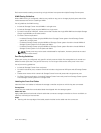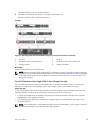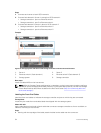
• If the host server is a Windows or Linux host:
a. Install the iSCSI HBAs or network adapters dedicated for iSCSI traffic in the host servers.
NOTE: Do not install iSCSI HBAs or network adapters from different vendors in the same
server.
b. Install supported drivers for the HBAs or network adapters and make sure that the HBAs or
network adapter have the latest supported firmware
c. Use the host operating system to assign IP addresses for each iSCSI port. The IP addresses must
match the subnets for each fault domain.
CAUTION: Correctly assign IP addresses to the HBAs or network adapters. Assigning IP
addresses to the wrong ports can cause connectivity issues.
NOTE: If using jumbo frames, they must be enabled and configured on all devices in the data
path, adapter ports, switches, and storage system.
d. Use the iSCSI cabling diagrams to cable the host servers to the switches. Connecting host servers
directly to the storage system without using Ethernet switches is not supported.
• If the host server is a vSphere host:
a. Install the iSCSI HBAs or network adapters dedicated for iSCSI traffic in the host servers.
b. Install supported drivers for the HBAs or network adapters and make sure that the HBAs or
network adapter have the latest supported firmware
c. If the host uses network adapters for iSCSI traffic, create a VMkernel port for each network
adapter. (1 VMkernel per vSwitch)
d. Use the host operating system to assign IP addresses for each iSCSI port. The IP addresses must
match the subnets for each fault domain..
CAUTION: Correctly assign IP addresses to the HBAs or network adapters. Assigning IP
addresses to the wrong ports can cause connectivity issues.
NOTE: If using jumbo frames, they must be enabled and configured on all devices in the data
path, adapter ports, switches, and storage system.
e. If the host uses network adapters for iSCSI traffic, add the VMkernel ports to the iSCSI software
initiator.
f. Use the iSCSI cabling diagrams to cable the host servers to the switches. Connecting host servers
directly to the
storage system without using Ethernet switches is not supported.
Two iSCSI Networks with Dual 10 GbE 2–Port Storage Controllers
Use two iSCSI networks to prevent an unavailable port, switch, or storage controller from causing a loss
of connectivity between the host servers and a storage system with dual 10 GbE 2–port storage
controllers.
About this task
In this configuration, there are two fault domains, two iSCSI networks, and two Ethernet switches. The
storage controllers connect to each Ethernet switch using one iSCSI connection.
• If a physical port or Ethernet switch becomes unavailable, the storage system is accessed from the
switch in the other fault domain.
• If a storage controller becomes unavailable, the virtual ports on the offline storage controller move to
the physical ports on the other storage controller.
Steps
1. Connect each server to both iSCSI networks.
2. Connect fault domain 1 (shown in orange) to iSCSI network 1.
• Storage controller 1: port 1 to Ethernet switch 1
Front-End Cabling
47


















